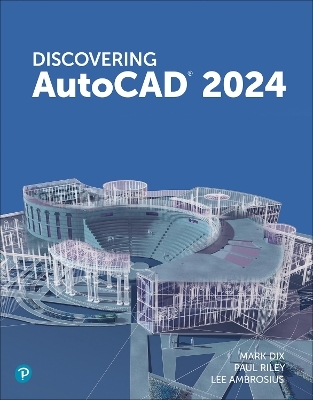
Discovering AutoCAD 2024
Peachpit Press Publications (Verlag)
978-0-13-823237-5 (ISBN)
Lessons are broken down into tasks listed at the beginning of each section, introducing students to the AutoCAD commands using a structured, intuitive approach and helping students anticipate what information will be needed at each new phase of the learning process.
General Procedure boxes appear as new commands are introduced, providing a simple overview of basic command sequences in a step-by-step format.
Detailed graphics demonstrate what students should expect to see on their screens, encouraging self-paced study.
Each chapter concludes with drawing problems to help students apply newly learned techniques immediately to realistic drawing situations. The problems include drawing suggestions, timesaving tips, and explanations of how to use techniques in actual situations.
Working drawings accompany the end-of-chapter drawing problems, appearing in a large, clearly dimensioned format on each right-hand page, with drawing suggestions on the accompanying left-hand page. This includes mechanical, architectural, civil, and electrical drawings.
End-of-chapter review questions to test the student's knowledge.
Discovering AutoCAD 2024 will be a valuable resource for any student wanting to learn drafting skills.
Mark Dix first worked with AutoCAD as a programmer in 1985. The following year he began collaborating with Paul Riley to create AutoCAD training material, combining Paul's background in industrial design with his own background in writing and curriculum development. Mark received an M.A.T. from Cornell University and an M.S. degree from the University of Massachusetts. Paul Riley was an early advocate for exposing students to the advantages of learning AutoCAD for career advancement. Paul holds a B.S. in Education and an M.S. in Computer Technology with a career that has included teaching at public high school, private college, public university, and technology companies in the Boston area. Lee Ambrosius has held many different roles in the industry and has a wide range of experience with AutoCAD. He started using AutoCAD in 1994, even before he began his professional career as a drafter in 1996. Along with being a drafter, Lee loosely held the position of CAD manager and later CAD systems analyst as his career pushed into software programming. As Lee's career matured, he began writing articles for Autodesk User Group International (AUGI) newsletters and publications, working on more than a dozen published AutoCAD books, instructing classes at a local community college, and even presenting at Autodesk University (AU) over the course of 18 consecutive years. Lee is actively involved with AutoCAD today, and he's still sharing his knowledge almost 30 years after drawing his first line object in the AutoCAD drawing window. He spends most of his days taking the complexities out of learning AutoCAD by breaking down workflows into basic learning lessons—the same approach used in his books. When not writing about AutoCAD, Lees spends his time running, playing arcade games, and enjoying his family (wife, three children, and the “fur” babies who really run the house) in Northeastern Wisconsin.
Part One Basic Two-Dimensional Entities
Chapter 1 Lines and Essential Tools
Chapter 2 Circles and Drawing Aids
Chapter 3 Layers, Colors, and Linetypes
Chapter 4 Templates, Copies, and Arrays
Chapter 5 Arcs and Polar Arrays
Chapter 6 Object Snaps and Resized Objects
Part Two Text, Dimensions, and Other Complex Entities
Chapter 7 Text
Chapter 8 Dimensions
Chapter 9 Polylines
Chapter 10 Blocks, Attributes, and External References
Part Three Isometric Drawing and Three-Dimensional Modeling
Chapter 11 Isometric Drawing
Chapter 12 3D Modeling
Chapter 13 More Modeling Techniques and Commands
Appendix A Drawing Projects
Appendix B Creating Custom Ribbon Panels
Appendix C Menus, Macros, and the CUI
Appendix D and Glossary are available online at peachpit.com/Discoverautocad2024.
| Erscheinungsdatum | 03.01.2024 |
|---|---|
| Verlagsort | Berkeley |
| Sprache | englisch |
| Maße | 216 x 280 mm |
| Gewicht | 1760 g |
| Themenwelt | Informatik ► Weitere Themen ► CAD-Programme |
| Technik ► Maschinenbau | |
| ISBN-10 | 0-13-823237-7 / 0138232377 |
| ISBN-13 | 978-0-13-823237-5 / 9780138232375 |
| Zustand | Neuware |
| Informationen gemäß Produktsicherheitsverordnung (GPSR) | |
| Haben Sie eine Frage zum Produkt? |
aus dem Bereich


